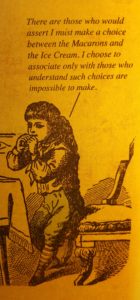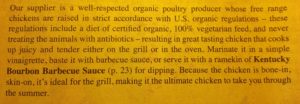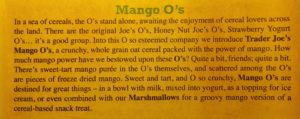Copywriting Lessons from Trader Joe’s
Now, I know what you’re thinking. Trader Joe’s is doing some guerrilla marketing, isn’t it?
Don’t worry—the advertisers haven’t bought me yet. This has nothing to do with advertising and everything to do with me stumbling across some marketing materials that have plenty of copywriting lessons to share.

There are those who would assert I must make a choice between the Macarons and the Ice Cream. I choose to associate only with those who understand such choices are impossible to make.
Disclaimer: I’ve never shopped at Trader Joe’s. I don’t know the story behind the company, who Joe is, or why he’s so interested in trading. But I have to admit, after reading through some of the ad copy found in Trader Joe’s Fearless Flyer Guide to Summer, I wouldn’t refuse payment for this article in the form of some mango mango mochi.
Trader Joe’s ad copy is a shining example of how to grab the attention of an audience and keep them interested all the way through. And it’s not just about the products. The Fearless Flyer employs several linguistic tricks and deftly woven turns of phrase to please any fan of the written word.
Copywriting Lessons from Trader Joe’s
Trader Joe’s has some pretty impressive minds going to work on its ad copy. The flyer caught my eye for the same reason, I believe, that that Trader Joe’s advertising works so well in general: it’s fun, relaxed, and doesn’t take itself too seriously.
Trader Joe’s takes a laid-back approach to its advertising copy. Little cartoons are peppered throughout its ads, highlighting the jovial nature of the brand. Despite its push towards natural, organic, and additive-free offerings, Trader Joe’s wants you to know right off the bat that it’s not stuck-up or snooty about its products.
But aside from the lighthearted tone, there are several other lessons that can be taken from the Trader Joe’s world.
Lesson #1: Know Your Audience
Trader Joe’s knocks our first copywriting principle out of the park: Know to whom you’re selling.
Joe’s is a brand that knows its audience well. Listen to the way the ad describes something as plain as boring old chicken:

Our supplier is a well-respected organic poultry producer whose free range chickens are raised in strict accordance with U.S. organic regulations – these regulations include a diet of certified organic, 100% vegetarian feed, and never treating the animals with antibiotics – resulting in great tasting chicken that cooks up juicy and tender either on the grill or in the oven. Marinate it in a simple vinaigrette, baste it with barbecue sauce, or serve it with a ramekin of Kentucky Bourbon Sauce (p.23) for dipping. Because the chicken is bone-in, skin-on, it’s ideal for the grill, making it the ultimate chicken to take you through the summer.
While maintaining its relaxed brand voice, Trader Joe’s is telling us several things:
- It deals with well-respected industry distributors to guarantee a quality product
- Free-range poultry and U.S. regulatory compliance for feed are a must
- Animals are free of antibiotics
- All of these factors contribute to great tasting chicken
“Great tasting chicken” is the bottom-line pitch, but rather than leading with it (as we’d expect from basic advertising), Trader Joe’s understands that its average customer appreciates natural foods and humane treatment of animals over cheap products; as such, promises about free-range poultry and industry professionalism come first in its copy.
Lesson #2: Advertising without Advertising
Have you ever seen an advertisement that really resonated with you without your knowing why?
I certainly have, and I’m willing to bet you have too. Some phrases just have that je ne sais quois that make them stick in our minds. This is part of the fun of writing and is the next of our copywriting lessons: Wordplay and deliberate use of linguistic tricks can support your text and reinforce ideas in readers’ minds. The following passage from the Fearless Flyer hits just the right notes:

In a twist on the more traditional mochi-wrapped ice cream we’ve been selling in our stores for many years, Trader Joe’s Mango Mango Mochi looks like ice cream, eats like ice cream, and yet, contains no ice cream. Or any dairy, for that matter. Actually, these two-bite size delights are dairy free, gluten free, soy free, and vegan. And yet… the pleasure of ice cream will be yours.
There’s plenty more going on here than mere advertisement. Sure, it’s clear that Trader Joe’s is proud of its natural ice cream alternative, but look closer at the way it’s described. The way Joe’s uses language to drive its points home could be included in a master’s class on copywriting lessons:
Looks like ice cream, eats like ice cream…
Dairy free, gluten free, soy free…
This is a rhetorical device known as “diacope,” defined as repetition of words or phrases with one or two words in between. Diacope is used to draw attention to the specific characteristics of something with the end goal of hammering the reader’s subconscious enough to build connections in his/her mind.
Here, Joe’s uses diacope to emphasize two key points:
- What you’re eating is very similar to ice cream; similar enough that you should just assume it’s ice cream and call it a day.
- What you’re eating should be considered natural and free of evil nonsense.
Okay, dairy and soy aren’t the most evil things in the world, but the features themselves don’t actually matter. We associate the suffix “-free” with positivity, particularly when it comes to food products.
Buy one get one free. Sugar free. Fat free. Preservative free.
By the time you’ve finished reading, Trader Joe’s subliminal verse has already worked its magic.
Even if readers tolerate gluten well and don’t give a flying fig that the dessert is gluten free, the way Joe’s describes it adds value in our consumer-oriented minds and makes us more likely to buy. And on top of everything else, diacope adds a nice rhythmic quality to your phrasing. It’s a win-win tactic for all copywriters.
Lesson #3: Storytelling
And speaking of melodic repetition, I had to read this one a few times before I really grasped how great it was:

In a sea of cereals, the O’s stand alone, awaiting the enjoyment of cereal lovers across the land. There are the original Joe’s O’s, Honey Nut Joe’s O’s, Strawberry Yogurt O’s… it’s a good group. Into this O so esteemed company we introduce Trader Joe’s Mango O’s, a crunchy, whole grain oat cereal packed with the power of mango. How much mango power have we bestowed upon these O’s? Quite a bit, friends; quite a bit. There’s a sweet-tart mango puree in the O’s themselves, and scattered among the O’s are pieces of freeze dried mango. Sweet and tart, and O so crunchy, Mango O’s are destined for great things – in a bowl with milk, mixed into yogurt, as topping for ice cream, or even combined with our Marshmallows for a groovy mango version of a cereal-based snack treat.
There’s so much to love in this paragraph, even aside from the copywriting lessons contained therein. This section is a good example of an advertisement utilizing the power of storytelling. Or at least, a few storytelling elements.
The very first line suggests a sense of grandeur, preparing the reader for a journey into a world where cereal reigns supreme. This is exactly what you want in sales copy—something fun that hooks a reader from the very first line. Of course, storytelling itself is nothing revolutionary as far as copywriting lessons go, but Joe’s makes perfect use of the tactic by giving readers something relatable to sink their teeth into before the information dump begins.
In the next few lines, Trader Joe’s lists the variety of cereals it offers as an introduction to its newest offering, a mango-based cereal. Maybe not so exciting on its own, but the way the copy drives the reader forward makes even a cereal description a theatrical experience. Joe’s personifies its products with phrases like “esteemed company” and adds dramatic flair with words like “bestowed,” “power,” and “destined.” By using powerful language and weaving basic narrative elements into its ad, Trader Joe’s makes a strong case for its product. Cereal has never been so compelling.
Learning from the Pros
As each of our copywriting lessons show, crafting effective copy is equal parts art and science. There are rules to follow, sure, but going by the book doesn’t always create copy that converts. Trader Joe’s understands this and adds a stylistic flair to its ads, ramping up its originality to 11. You don’t need to be a fan of natural foods and coconut oil body butters to appreciate the copy that Joe’s provides. The next time you’re near a Trader Joe’s, pick up a flyer and see for yourself. You don’t need to buy anything. Just crack open the pages and see firsthand how to make people hungry for your product.
Greg Hill is a copywriter from the Midwest who only sort of understands artisinal coffee.

